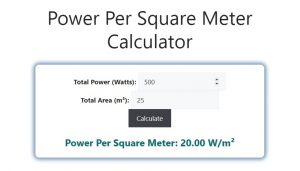About Power Per Square Meter Calculator (Formula)
A Power Per Square Meter (PPSM) Calculator is a useful tool for determining the amount of power distributed over a specific area. This is especially important in applications such as solar energy, electrical engineering, and HVAC systems, where understanding power density helps in optimizing efficiency. By calculating the power per square meter, you can ensure that energy is used effectively over a given surface area.
Formula
The formula for calculating power per square meter is:
PPSM = Total Power / Total Area.
In this formula, PPSM represents the power per square meter, Total Power is the overall power output or input, and Total Area refers to the area over which the power is distributed.
How to Use
Using a Power Per Square Meter Calculator is simple and requires a few easy steps:
- Measure the Total Power: Find the total power in watts (W) or another consistent unit.
- Determine the Total Area: Measure the area in square meters (m²) or other applicable units.
- Input the Values: Enter the total power and area into the calculator.
- Calculate: The calculator will apply the formula and provide the power per square meter.
- Interpret the Results: Use the result to assess the power density and make adjustments as needed.
Example
Let’s say you have a solar panel system that generates 500 watts of power and covers an area of 25 square meters. Using the formula:
PPSM = Total Power / Total Area
PPSM = 500W / 25m²
PPSM = 20W/m²
This means that 20 watts of power are distributed per square meter of the panel’s surface.

FAQs
- What is power per square meter?
Power per square meter measures the amount of power distributed over a given area. - Why is it important to calculate power per square meter?
It helps optimize the efficiency of power usage over a surface, ensuring that energy is used effectively. - What units are used for power and area?
Power is typically measured in watts (W), and area is measured in square meters (m²). - Can I use this calculator for solar energy calculations?
Yes, it is commonly used to determine the power output of solar panels based on their surface area. - How does increasing the area affect the power per square meter?
Increasing the area with the same power will decrease the power density, as the power is spread over a larger surface. - What happens if I increase the power output?
Increasing the power output with the same area will result in a higher power per square meter. - Can this calculator be used for HVAC systems?
Yes, it is useful for calculating heat distribution or cooling efficiency over a given space. - What should I do if my result seems too high or too low?
Double-check the units of your power and area measurements to ensure they are consistent. - Is power per square meter important in acoustics?
Yes, in acoustics, it can be used to calculate the intensity of sound over a surface area. - How do I measure total power?
Total power can be measured with a power meter, or it can be provided by your system’s specifications. - Can I calculate power per square meter for any surface?
Yes, as long as you know the total power and the area, you can calculate power per square meter for any surface. - What is a common use of this calculation in renewable energy?
It is often used to assess the performance of solar panels by determining how much power is produced per unit area. - Can this calculator be used for electrical power distribution?
Yes, it can help determine how effectively electrical power is distributed across different areas of a grid or system. - Does the calculator account for power losses?
No, this calculator assumes the total power is delivered evenly across the area without losses. - Is there a limit to the area size I can use?
There is no limit to the area size, but larger areas with the same power will result in lower power per square meter. - Can I use this calculator for lighting systems?
Yes, it’s useful for assessing the intensity of light output over a certain area. - What is the difference between power per square meter and energy per square meter?
Power refers to the rate of energy transfer, while energy per square meter would measure the total energy distributed over time. - Can this calculator help in thermal energy applications?
Yes, it is helpful in determining heat distribution over a surface, particularly in HVAC and heating systems. - What if my area is not measured in square meters?
You can convert the area to square meters or use consistent units to calculate power density. - Where can I find a Power Per Square Meter Calculator?
Many online calculators are available, or you can manually calculate using the formula provided.
Conclusion
A Power Per Square Meter Calculator is essential for anyone needing to measure how power is distributed over an area, especially in fields like solar energy, electrical engineering, and HVAC systems. With the simple formula and easy-to-follow instructions, you can accurately assess power density and make adjustments to optimize efficiency.
